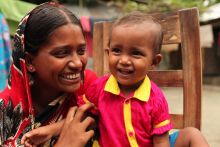
Here’s a good news-bad news story with a twist. The good news is that a concerted global effort has lowered the number of children around the world who die every year before they reach their fifth birthday from 12 million in 1990 to about six million now. That means more than five million children are alive now than would have been before.
The bad and, for me, unconscionable news is that some six million children are still dying annually, about one million of them within hours of taking their first breath. Here’s the twist: we know how to turn this bad news into good news. These deaths are preventable. It’s a pretty simple process, and it can happen in our lifetimes.
The struggle to eliminate preventable child deaths and preserve the lives of their mothers and pregnant women everywhere received a huge boost this week with Prime Minister Stephen Harper’s announcement of a global summit on maternal, newborn and child health, aptly named Saving Every Woman, Every Child. The summit will be held in Toronto on May 28-30, 2014.
I expect this gathering will ignite a process to end preventable child and maternal deaths over the next 15 years. The summit will bring together high-profile leaders and the best health and development experts needed to make this happen – many of whom are Canadian – and include UN Secretary General Ban Ki-moon, Melinda Gates and government heads from around the world.
In 2000, nations around the globe pledged to build a better world by 2015 through a series of eight Millennium Development Goals (MDGs). Among them were reducing the under-five mortality rate by two-thirds and the maternal mortality rate by three-quarters. However, after a decade it became clear that these objectives would not be met unless there was an urgent re-dedicated and enhanced effort.
Plan Canada joined forces with other development organizations to make saving the lives of women and children a major priority for the June 2010 G-8 Summit, hosted by Canada. With broad public support, Prime Minister Harper put this issue at the top of the agenda. The resulting Muskoka Initiative leveraged billions of dollars in new money from countries around the world earmarked for keeping alive mothers and children who die needlessly.
That investment worked.
More children are reaching their fifth birthday and the number of mothers dying in childbirth has been halved. Canadians can take enormous pride in our efforts and leadership launched four years ago. The rest of the world applauds that leadership, too.
But this next summit will address the crucial questions of “What next?” and “Who have we left behind?”
The pregnant women and children who still make up current mortality statistics are among the most vulnerable and hardest to reach. They live in isolated communities, far from big-city hospitals. They live in war-torn areas where many local medical personnel have fled for their lives. They lack access to nutritious food or medical information to stay healthy during pregnancy. These women and children may face discrimination as members of ethnic minorities. Many are disabled or orphans.
Walking that last mile to reach these most vulnerable is going to be the toughest leg of our collective journey to save lives. However, while the challenge is great, the solutions are stunningly straightforward.
We don’t need any medical or technological breakthroughs. We do need to strengthen healthcare delivery infrastructures so that they reach rural, remote and under-serviced areas. The most simple, cost-effective and proven measure is to train and place more birth attendants and community health workers among vulnerable populations. These nurses, midwives and others with basic training will ensure that more women are seen regularly during pregnancy and receive post-natal care. The world needs several hundred thousand of these people.
Clearly, there is some cost. But we have shown over the last four years that this is an investment with a remarkable return. We committed to accountability and we will continue to share the results about lives saved, deaths averted, and healthy and thriving mothers and children.
To maintain momentum and build on progress to date, Canada needs to renew its five-year $2.85 billion maternal, newborn and child health commitment that expires next year, but also add close to $400 million in new funding to save the lives of the most vulnerable and difficult women and children to reach – the ones we have left behind so far.
World Bank President Jim Yong Kim has said we can end extreme poverty by 2030. I believe this is a realistic goal. But to get there, we must make maternal and child health the centrepiece of our efforts. Because unless mothers are surviving and producing healthy babies who thrive and become educated children, these children can’t contribute as adults to the eradication of poverty in their communities and countries.
The Canadian summit needs to endorse boldly accelerated efforts and resources for those left behind, so we can finish the job we started in 2010 and shape the agenda for the post-MDG era. Continued Canadian leadership is expected around the world. The world should expect no less from Canada. We know what to do. We can’t afford to miss this opportunity to save every woman and every child we can.
Source: Ottawa Citizen
Publié:
mai 2, 2014
Auteur:
Rosemary McCarney, President and CEO of Plan Canada
Catégories:
Partager cette publication: